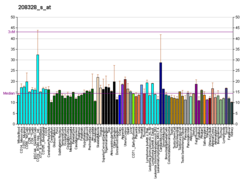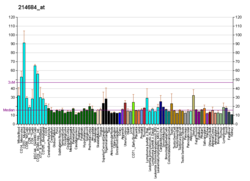Myocyte-specific enhancer factor 2A
Myocyte-specific enhancer factor 2Ais aproteinthat in humans is encoded by theMEF2Agene.[5][6]MEF2A is atranscription factorin theMef2family. In humans it is located onchromosome 15q26.Certainmutationsin MEF2A cause anautosomal dominantform ofcoronary artery diseaseandmyocardial infarction.
Function[edit]
The process of differentiation from mesodermal precursor cells to myoblasts has led to the discovery of a variety of tissue-specific factors that regulate muscle gene expression. The myogenic basic helix-loop-helix proteins, including myoD (MIM 159970), myogenin (MIM 159980), MYF5 (MIM 159990), and MRF4 (MIM 159991) are 1 class of identified factors. A second family of DNA binding regulatory proteins is the myocyte-specific enhancer factor-2 (MEF2) family. Each of these proteins binds to the MEF2 target DNA sequence present in the regulatory regions of many, if not all, muscle-specific genes. The MEF2 genes are members of the MADS gene family (named for the yeast mating type-specific transcription factor MCM1, the plant homeotic genes 'agamous' and 'deficiens' and the human serum response factor SRF (MIM 600589)), a family that also includes several homeotic genes and other transcription factors, all of which share a conserved DNA-binding domain.[supplied by OMIM][6]
Interactions[edit]
Myocyte-specific enhancer factor 2A has been shown tointeractwith:
References[edit]
- ^abcGRCh38: Ensembl release 89: ENSG00000068305–Ensembl,May 2017
- ^abcGRCm38: Ensembl release 89: ENSMUSG00000030557–Ensembl,May 2017
- ^"Human PubMed Reference:".National Center for Biotechnology Information, U.S. National Library of Medicine.
- ^"Mouse PubMed Reference:".National Center for Biotechnology Information, U.S. National Library of Medicine.
- ^Yu YT, Breitbart RE, Smoot LB, Lee Y, Mahdavi V, Nadal-Ginard B (October 1992)."Human myocyte-specific enhancer factor 2 comprises a group of tissue-restricted MADS box transcription factors".Genes Dev.6(9): 1783–98.doi:10.1101/gad.6.9.1783.PMID1516833.
- ^ab"Entrez Gene: MEF2A MADS box transcription enhancer factor 2, polypeptide A (myocyte enhancer factor 2A)".
- ^Mao Z, Nadal-Ginard B (June 1996)."Functional and physical interactions between mammalian achaete-scute homolog 1 and myocyte enhancer factor 2A".J. Biol. Chem.271(24): 14371–5.doi:10.1074/jbc.271.24.14371.PMID8662987.
- ^abDe Luca A, Severino A, De Paolis P, Cottone G, De Luca L, De Falco M, Porcellini A, Volpe M, Condorelli G (February 2003)."p300/cAMP-response-element-binding-protein ('CREB')-binding protein (CBP) modulates co-operation between myocyte enhancer factor 2A (MEF2A) and thyroid hormone receptor-retinoid X receptor".Biochem. J.369(Pt 3): 477–84.doi:10.1042/BJ20020057.PMC1223100.PMID12371907.
- ^abMiska EA, Karlsson C, Langley E, Nielsen SJ, Pines J, Kouzarides T (September 1999)."HDAC4 deacetylase associates with and represses the MEF2 transcription factor".EMBO J.18(18): 5099–107.doi:10.1093/emboj/18.18.5099.PMC1171580.PMID10487761.
- ^abcLemercier C, Verdel A, Galloo B, Curtet S, Brocard MP, Khochbin S (May 2000)."mHDA1/HDAC5 histone deacetylase interacts with and represses MEF2A transcriptional activity".J. Biol. Chem.275(20): 15594–9.doi:10.1074/jbc.M908437199.PMID10748098.
- ^Zhao M, New L, Kravchenko VV, Kato Y, Gram H, di Padova F, Olson EN, Ulevitch RJ, Han J (January 1999)."Regulation of the MEF2 family of transcription factors by p38".Mol. Cell. Biol.19(1): 21–30.doi:10.1128/mcb.19.1.21.PMC83862.PMID9858528.
- ^Yang SH, Galanis A, Sharrocks AD (June 1999)."Targeting of p38 mitogen-activated protein kinases to MEF2 transcription factors".Mol. Cell. Biol.19(6): 4028–38.doi:10.1128/mcb.19.6.4028.PMC104362.PMID10330143.
- ^Ornatsky OI, McDermott JC (October 1996)."MEF2 protein expression, DNA binding specificity and complex composition, and transcriptional activity in muscle and non-muscle cells".J. Biol. Chem.271(40): 24927–33.doi:10.1074/jbc.271.40.24927.PMID8798771.
- ^Quinn ZA, Yang CC, Wrana JL, McDermott JC (February 2001)."Smad proteins function as co-modulators for MEF2 transcriptional regulatory proteins".Nucleic Acids Res.29(3): 732–42.doi:10.1093/nar/29.3.732.PMC30396.PMID11160896.
Further reading[edit]
- Wang Q (2005)."Advances in the Genetic Basis of Coronary Artery Disease".Current Atherosclerosis Reports.7(3): 235–41.doi:10.1007/s11883-005-0012-6.PMC1783687.PMID15811259.
- Wang Q (2005)."Molecular genetics of coronary artery disease".Curr. Opin. Cardiol.20(3): 182–8.doi:10.1097/01.hco.0000160373.77190.f1.PMC1579824.PMID15861005.
- Funk WD, Wright WE (1992)."Cyclic amplification and selection of targets for multicomponent complexes: myogenin interacts with factors recognizing binding sites for basic helix-loop-helix, nuclear factor 1, myocyte-specific enhancer-binding factor 2, and COMP1 factor".Proc. Natl. Acad. Sci. U.S.A.89(20): 9484–8.Bibcode:1992PNAS...89.9484F.doi:10.1073/pnas.89.20.9484.PMC50156.PMID1329097.
- Pollock R, Treisman R (1992)."Human SRF-related proteins: DNA-binding properties and potential regulatory targets".Genes Dev.5(12A): 2327–41.doi:10.1101/gad.5.12a.2327.PMID1748287.
- Molkentin JD, Black BL, Martin JF, Olson EN (1996)."Cooperative activation of muscle gene expression by MEF2 and myogenic bHLH proteins".Cell.83(7): 1125–36.doi:10.1016/0092-8674(95)90139-6.PMID8548800.
- Hobson GM, Krahe R, Garcia E, Siciliano MJ, Funanage VL (1996). "Regional chromosomal assignments for four members of the MADS domain transcription enhancer factor 2 (MEF2) gene family to human chromosomes 15q26, 19p12, 5q14, and 1q12-q23".Genomics.29(3): 704–11.doi:10.1006/geno.1995.9007.PMID8575763.
- Mao Z, Nadal-Ginard B (1996)."Functional and physical interactions between mammalian achaete-scute homolog 1 and myocyte enhancer factor 2A".J. Biol. Chem.271(24): 14371–5.doi:10.1074/jbc.271.24.14371.PMID8662987.
- Suzuki E, Lowry J, Sonoda G, Testa JR, Walsh K (1996). "Structures and chromosome locations of the human MEF2A gene and a pseudogene MEF2AP".Cytogenet. Cell Genet.73(3): 244–9.doi:10.1159/000134348.PMID8697817.
- Ornatsky OI, McDermott JC (1996)."MEF2 protein expression, DNA binding specificity and complex composition, and transcriptional activity in muscle and non-muscle cells".J. Biol. Chem.271(40): 24927–33.doi:10.1074/jbc.271.40.24927.PMID8798771.
- Black BL, Molkentin JD, Olson EN (1998)."Multiple Roles for the MyoD Basic Region in Transmission of Transcriptional Activation Signals and Interaction with MEF2".Mol. Cell. Biol.18(1): 69–77.doi:10.1128/mcb.18.1.69.PMC121453.PMID9418854.
- Yang CC, Ornatsky OI, McDermott JC, Cruz TF, Prody CA (1998)."Interaction of myocyte enhancer factor 2 (MEF2) with a mitogen-activated protein kinase, ERK5/BMK1".Nucleic Acids Res.26(20): 4771–7.doi:10.1093/nar/26.20.4771.PMC147902.PMID9753748.
- Zhao M, New L, Kravchenko VV, Kato Y, Gram H, di Padova F, Olson EN, Ulevitch RJ, Han J (1999)."Regulation of the MEF2 Family of Transcription Factors by p38".Mol. Cell. Biol.19(1): 21–30.doi:10.1128/mcb.19.1.21.PMC83862.PMID9858528.
- Yang SH, Galanis A, Sharrocks AD (1999)."Targeting of p38 Mitogen-Activated Protein Kinases to MEF2 Transcription Factors".Mol. Cell. Biol.19(6): 4028–38.doi:10.1128/mcb.19.6.4028.PMC104362.PMID10330143.
- Iida K, Hidaka K, Takeuchi M, Nakayama M, Yutani C, Mukai T, Morisaki T (1999)."Expression of MEF2 genes during human cardiac development".Tohoku J. Exp. Med.187(1): 15–23.doi:10.1620/tjem.187.15.PMID10458488.
- Miska EA, Karlsson C, Langley E, Nielsen SJ, Pines J, Kouzarides T (1999)."HDAC4 deacetylase associates with and represses the MEF2 transcription factor".EMBO J.18(18): 5099–107.doi:10.1093/emboj/18.18.5099.PMC1171580.PMID10487761.
- Mao Z, Bonni A, Xia F, Nadal-Vicens M, Greenberg ME (1999). "Neuronal activity-dependent cell survival mediated by transcription factor MEF2".Science.286(5440): 785–90.doi:10.1126/science.286.5440.785.PMID10531066.
- Lu J, McKinsey TA, Nicol RL, Olson EN (2000)."Signal-dependent activation of the MEF2 transcription factor by dissociation from histone deacetylases".Proc. Natl. Acad. Sci. U.S.A.97(8): 4070–5.Bibcode:2000PNAS...97.4070L.doi:10.1073/pnas.080064097.PMC18151.PMID10737771.
- Lemercier C, Verdel A, Galloo B, Curtet S, Brocard MP, Khochbin S (2000)."mHDA1/HDAC5 histone deacetylase interacts with and represses MEF2A transcriptional activity"(PDF).J. Biol. Chem.275(20): 15594–9.doi:10.1074/jbc.M908437199.PMID10748098.S2CID39220205.
- Youn HD, Grozinger CM, Liu JO (2000)."Calcium regulates transcriptional repression of myocyte enhancer factor 2 by histone deacetylase 4".J. Biol. Chem.275(29): 22563–7.doi:10.1074/jbc.C000304200.PMID10825153.










